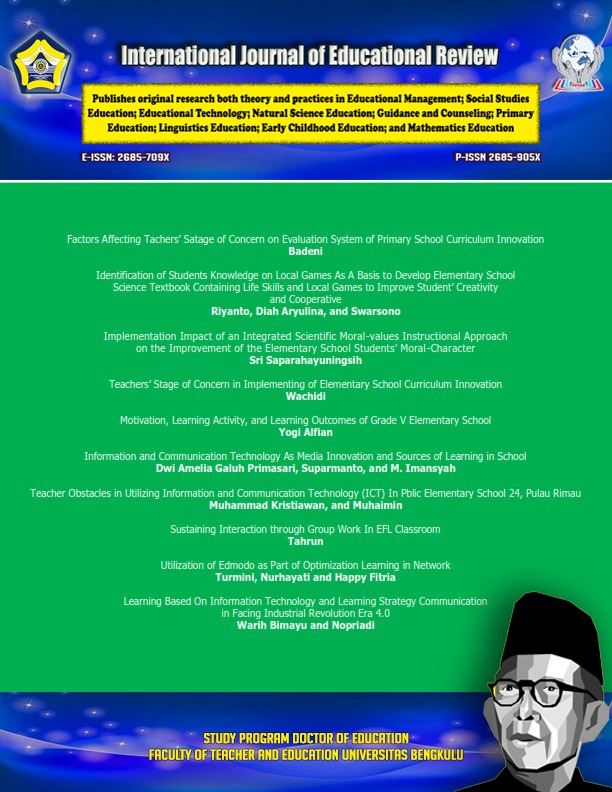The Place of Information and Communication Technology in the Effective Teaching and Learning of History in the Nigerian Educational Institutions In The 21st Century
DOI:
https://doi.org/10.33369/ijer.v4i2.23689Keywords:
Information And Communication Technology, Effective Teaching And Learning , Educational InstitutionsAbstract
The main thrust of this paper is to critically examine the place of Information and Communication Technology (ICT) in the effective Teaching and Learning of History in the Nigerian institutions in the 21st century. It argues that the new Information and communication technologies of internet and multimedia which have led to positive impact in the field of education in most developed countries are still at infancy or not used at all in the classroom instruction in most developing countries (Nigeria inclusive). ICTs are potential powerful enabling tools for effective teaching and learning in educational institutions. Thus, the paper argues that the central role of ICT is to provide additional strategies that can be used to address major educational challenges being faced by teachers and students of History Nigerian educational institutions in the 21st century. The paper, therefore, concludes that the appropriate use of ICTs can positively influence and change traditional methods of teaching and learning of History in Nigerian educational institutions, thereby making the teaching and learning of History more concrete. The methodology adopted in this paper is qualitative and analytical utilizing materials from the primary and secondary sources
References
Adedoyin AA, Akinnuwesi BA, Adegoke MA (2010). The Prospects and Challenges of ICT in Nigeria Tertiary Education. Revitalization Afr. Higher Educ. pp.278-285.
Adesote SA and Omojeje AV (2011). The Place of Educational Media in the Teaching and Learning of History in Nigerian Senior Secondary Schools. Journal of Education, Administration and Planning, vol. 3(1):9-14.
Adesote, S.A and Falade, D.A (20200. Distinct Comprehensive History for Senior Secondary School 1-3. Ondo: Unique Mercy and Features
Akudolu P (2007). ICT and Educational Development. Journal of Educational Studies, Vol. 10 (2): 12-21.
Carr EH (1954). A History of Soviet Russia: The Interregnum 19231924, London: Macmillan.
Clarke A (2006). Teaching adults ICT skills. Glasgow: Learning Matters Limited. pp.12-23.
Collingwood RG (1973). The Idea of History. London: Oxford University Press. pp. 10-23.
Duffy T, Cunningham D (1996). Constructivism: Implications for the design and delivery of instruction, Handbook of research for educational telecommunications and technology, New York: MacMillan. pp.170-198.
Falola T, Mahadi, A, Uhomoibhi A (1989). History of Nigeria 1. Ibadan: Longman Publishers Limited. pp.1-2.
Garrison R, Anderson T (2003). E-Learning in the 21st Century: A Framework for Research and Practice. Routledge Falmer, London.
Haddad W, Jurich S (2002). ICT for education: Potential and Potency. In W. Haddad & D. Drexler (Eds.), Technologies for Education: Potential, Parameters, and Prospects. Washington, DC: Academy for Educational Development and Paris: UNESCO pp.34-37.
Jonassen D, Reeves T (1996). Learning with technology: Using computers as cognitive tools. In D. Jonassen (Ed.), Handbook of Research Educational on Educational Communications and Technology. NewYork: Macmillan. pp.693-719.
Kamal BN, Banu AT (2010). ICT in Higher Education – A Study. Can. J. Data Inf. Knowl. Eng. 1(1):23-33.
Kennewell S (2004). The nature of ICT as a subject. In Kennewell, S; Parkinson, J and Tanner, H (Eds) Learning to teach ICT in the secondary school 18-36, London: Routledge Falmer. pp.23-29.
Lallana EC, Margaret UY (2003). The information age. Retrieved July, 25, 2013 from www.eprimers.org .
Lebow D (1993). Constructivist values for instructional systems design: Five principles toward a new mindset. Educ. Technol. Res. Dev. 41(3):4-16.
McCausland H, Wache D, Berk M (1999). Computer literacy; its implications and outcomes. A case study from the Flexible Learning Centre. University of South Australia. pp.6-9.
McCormick R, Scrimshaw P (2001) Information and Communications Technology, Knowledge and Pedagogy. Educ. Commun. Info. 1 (1): 37-57.
Ogbogbo, C.B.N (2011). Beyond Nomenclature: Current Challenges of Historical Scholarship In Nigeria. Journal of the Historical Society of Nigeria, Vol. 20, pp. 166-178
Oliver R (2000). Creating Meaningful Contexts for Learning in Webbased Settings. Proceedings of Open Learning 2000. Brisbane: Learning Network, Queensland. Ppp.53-62.
Osokoya IO (1997). Wrting and Teaching History. Ibadan: Laurel Educational Publishers. pp.11-21.
Otakhor EO (2007). Facilitating Improved Education Service Delivery in Nigerian Universities: The Relevance of Information and Communication Technology (ICT) Revolution. In Babalola J.B., Akpa G.O., Ayeni A.O. (Eds.) Managing Technical and Vocational Education in the Era of Globalization. NAEAP Publications. pp.27-35.
Pelgrum W, Law N (2003). ICT in education around the world: trends problems and prospects, Paris: Learning Matters Limited. pp.12-24.
Salau KK (2005). Computer Application and Information Technology. Ilorin: Nathadex Publishers. pp.36-45.
Shikshak S (2009). Information and Communication Technology for Quality Education Academy of Fine Arts. Vikramshila Educ. Resour. Soc. pp.1-20.
Soloway E, Pryor A (1996). The next generation in human-computer interaction. Communications of the ACM. 39(4):16-18.
Stephenson J Ed. (2001). Learner-managed learning- an emerging pedagogy for online learning. Teaching and Learning Online: Pedagogies for New Technologies. London, Kogan. pp.1-10.
Tanner H (2003). The place of ICT in secondary education. In Kennewell S; Parkinson J; and Tanner, H. (Eds). Learning to teach ICT in the Secondary School 37-46, London: Routledge Falmer. pp.12-25.
The Guardian, Friday April, 6, 2012 p6.
Wagner AD (2001) IT and Education for the Poorest of the Poor: Constraints, Possibilities, and Principles. Tech KnowLogia, July/August, 48-50.
Downloads
Published
How to Cite
Issue
Section
License

This work is licensed under a Creative Commons Attribution-ShareAlike 4.0 International License.




